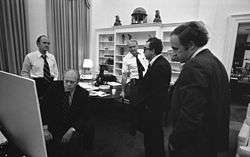Operation Fluid Drive
Operation Fluid Drive was a non-combatant evacuation operation led by the United States to evacuate American citizens and other foreign nationals from Beirut, Lebanon, during the Lebanese Civil War.[1] On 20 June 1976, USS Spiegel Grove transported 110 Americans and 157 nationals of other countries from Lebanon to Piraeus, Greece.[2] On 27 July, 300 additional persons, including 155 Americans, were evacuated to Piraeus.[3] The cruiser USS Little Rock was present off the Lebanese coast during both evacuations.[4]
First evacuation

United States President Gerald Ford ordered commencement of the operation on 20 June 1976 at 1:23 a.m. EDT.[5] Fighting on land routes to Damascus, Syria, disrupted the original plan of a road convoy evacuation.[6]
At 10:37 a.m. Beirut time, the United States Navy LCU 1654 landing craft opened its bow ramp at Bain Militaire to allow 276 evacuees to board.[5] U.S. diplomats in Lebanon had finished the truce arrangements needed for the evacuation only hours beforehand.[8] The evacuees were unarmed, and were escorted by numerous Palestinian guerrillas and leftist Lebanese army soldiers.[8][6] One family refused to continue with the evacuation when told, incorrectly, that their dog was not allowed.[2]
After a 25-minute trip, the landing craft reached USS Spiegel Grove, which remained three miles offshore.[8] The United States Sixth Fleet flagship, USS Little Rock, pulled alongside USS Spiegel Grove to greet the refugees on board.[8] The United States convoy consisted of five ships in total. One of the escort ships was the USS Connole FF 1056, and three Soviet warships, including Kerch, shadowed the fleet.[8] USS Spiegel Grove then sailed to Piraeus, Greece, arriving on 22 June 1976.[6][9]
Second evacuation
On 26 July 1976, the Sixth Fleet prepared to evacuate an additional 500 Americans and others from Lebanon.[10] Dockside security was again provided by the Palestine Liberation Organization.[10] Although 500 people were signed up to leave the country, only 155 Americans and 145 nationals of other countries were evacuated.[3]
References
- "CBS Evening News for Sunday, Jun 20, 1976". Retrieved 26 October 2012.
- "Evacuees aboard ship in party mood". The Miami News. 21 June 1976. Retrieved 30 October 2012.
- "Lebanon Truce Signed". The Palm Beach Post. Beirut. 30 July 1976. Retrieved 30 October 2012.
- "USS Little Rock 1975 Beirut Civil War". USS Little Rock Association. Retrieved 26 October 2012.
- "Americans Flee Beirut". St. Petersburg Times. Beirut. 21 June 1976. Retrieved 28 October 2012.
- "263 leave Lebanon aboard U.S. vessel". The Gazette. Beirut. 21 June 1976. Retrieved 28 October 2012.
- McManus, Doyle (22 June 1976). "U.S. Rescue Ship in 'Fluid Drive' From Lebanon Peril". The Schenectady Gazette. Aboard USS Spiegel Grove. Retrieved 28 October 2012.CS1 maint: location (link)
- MEED Arab Report. London: Middle East Economic Digest Ltd. 1976.
- "6th Fleet to evacuate 500 from Lebanon". The Morning Record. Beirut. 27 July 1976. Retrieved 30 October 2012.
| Wikimedia Commons has media related to Operation Fluid Drive. |